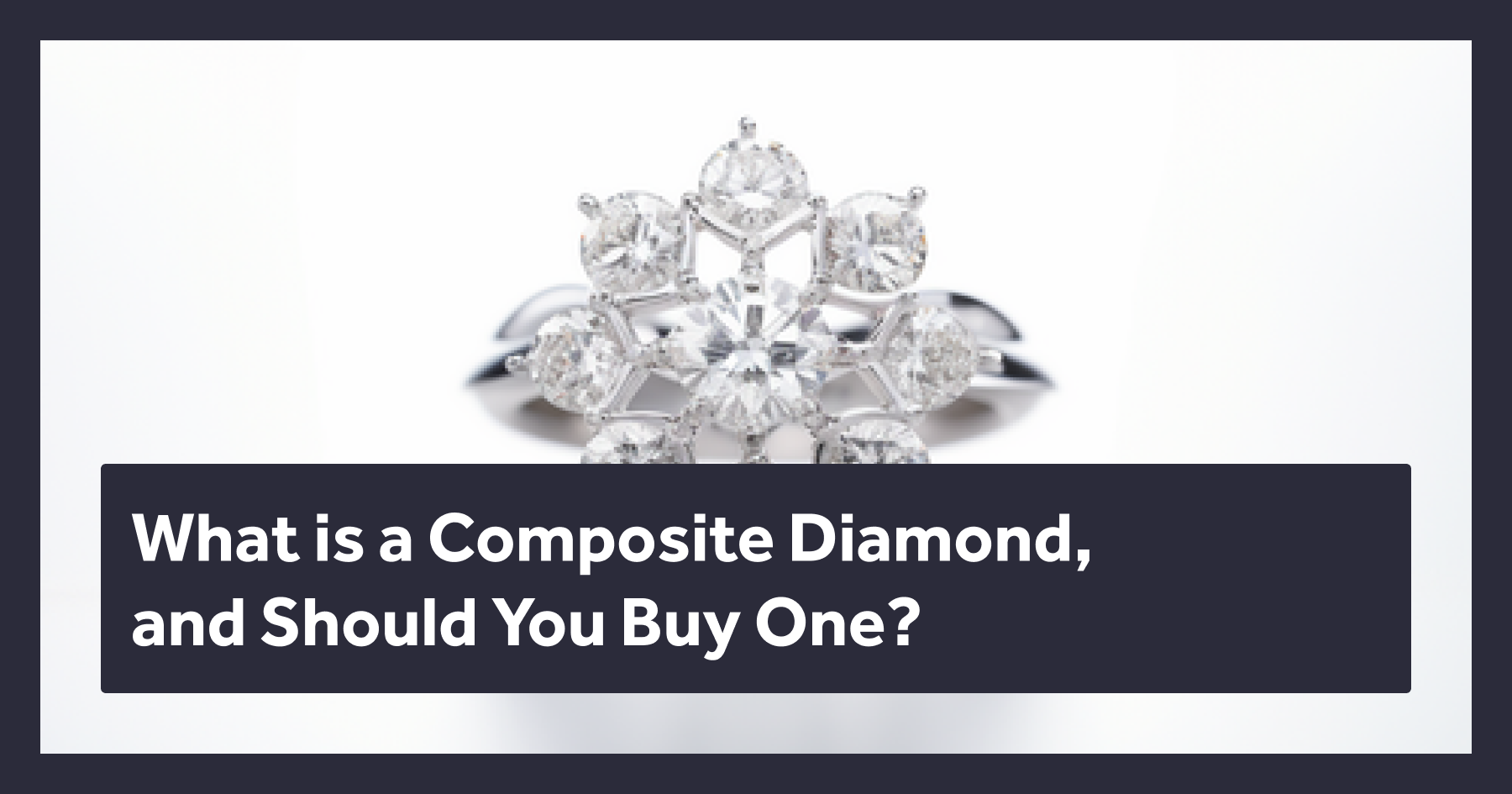
Catering to jewelry enthusiasts and prospective buyers alike, the intricate world of gemstones often presents a dazzling array of choices that can sometimes overwhelm even the most discerning individuals. Amidst this sparkling confusion, composite diamonds emerge as a captivating subject, merging artful craftsmanship with the timeless allure of diamonds.
If you're asking: "What is a composite diamond?" this article clarifies the essence of composite diamonds, their place in the jewelry market, and their value compared to their solitaire counterparts.
What is a Composite Diamond?
Composite diamonds are not a single entity but a mosaic of tiny stones meticulously placed together to craft a larger-looking diamond ring. This ingenious arrangement elevates the ring's glamour and sparkle and presents an alternative to the traditional diamond ring many have come to know.
By utilizing natural diamonds and their lab-made counterparts, composite pieces maintain the revered hardness characteristic of diamonds, ensuring durability synonymous with the gemstone's legacy.
The creation process of these composite beauties involves carefully selecting and matching tiny diamonds, most certainly smaller than one carat, to form a unified, larger appearance.
A composite diamond ring's total carat weight (TCW) is the sum of all the diamonds combined, offering a decent weight at an often more affordable price.
However, the brilliance of a composite ring or jewelry may not match that of a single diamond set alone due to the smaller size and arrangement of multiple stones. Jewelers, therefore, employ strategic settings that maximize light performance, drawing out the best possible fire and sparkle from the assembly.
Understanding the Characteristics of Composite Diamonds

Crafters tend to make composite diamond rings with smaller diamonds, which are rarely certified due to their size. While this absence of certification might raise concerns about quality, it does not definitively indicate that composite diamonds are of inferior quality.
In fact, their composition allows for a larger and arguably more impressive visual impact, which can be particularly enticing for those with a penchant for intricate detailing and an eye for grandeur.
The value proposition of composite diamonds lies in their ability to mimic the presence of a larger diamond without the hefty price tag.
Those who dream of wearing a large diamond ring but have budget constraints will find composite diamonds an alluring solution. Composite diamonds provide the same sparkle and feel as real diamonds, offering a unique aesthetic that distinguishes them from traditional diamonds.
The advantages of composite diamonds extend beyond their visual appeal; they offer a distinctive look ranging from modern and avant-garde to classic and romantic.
However, while they do offer a larger appearance, they may not provide the same level of sparkle as a solitaire diamond ring. This is primarily because a single diamond has fewer obstructions to light performance when compared to multiple smaller diamonds set together.
Furthermore, the lack of certification may deter some buyers who prioritize documented quality assurance in their fine jewelry purchases.
The Market Outlook for Composite Diamond Jewelry
Looking at the market position of composite versus single-stone diamond investments, it becomes evident that price is a significant factor.
If you're looking for the sparkle of a big diamond but don't want to empty your wallet, composite diamond pieces could be your answer. They're a hit for their ability to mimic a larger gem without burning a hole in your pocket. Jewelers have caught on to this trend and now showcase composite diamond rings as a savvy, fashionable choice for the budget-conscious buyer.
Evaluating and Caring for Composite Diamonds

Just like with investing in diamond Coins and Bars, when you're dipping your toes into the composite diamond scene, there's a bit you'll want to keep in mind. It's not just about picking the prettiest piece. You have to consider several crucial factors, including:
- The quality and certification of the diamonds
- Total carat weight relative to the price
- The design's ability to reflect light and enhance the stone's natural brilliance
To assist in this process, here's a checklist of tips for evaluating composite diamond jewelry:
- Check for reputable jeweler credentials
- Understand future repair and maintenance costs
- Assess the intricacy of design and setting quality
This checklist aims to ensure prospective buyers can confidently navigate the composite diamond landscape and make a choice that resonates with their personal style and budget.
While the allure of a composite diamond engagement ring is undeniable, the practicalities of care and maintenance must also be considered. Like any piece of fine jewelry, composite diamonds require attention to retain their sparkle and structure.
Simple steps such as keeping them clean with warm water and a soft brush and storing them in a cloth-lined jewelry box can go a long way in preserving their beauty.
However, it is also essential to be cognizant of potential future repair costs, as composite diamond pieces may be more prone to damage due to their intricate detailing and multiple setting points. So prospective buyers should be prepared for the possibility of extra care and maintenance.
The setting of multiple small diamonds may necessitate more frequent checks to ensure that none of the stones have loosened—a scenario that could lead to loss or damage. While these considerations should not deter those enamored with the composite diamond's charm, they should certainly be factored into the overall investment decision.
Verdict: Should You Buy Composite Diamond Jewelry?

The question at the heart of this exploration remains: Should you buy one?
The answer, as with many fine jewelry inquiries, is subjective. Composite diamonds offer a distinctive blend of affordability, style, and the larger diamond look, making them an enticing choice for many.
However, a traditional diamond ring may be more suitable for those who prioritize the unmatched sparkle of a single, larger diamond or are keen on having a certified stone.
The suitability of composite diamonds also depends on individual taste and lifestyle. Those who favor intricate designs and are looking for a statement piece at a more accessible price may find composite diamonds the perfect fit. Conversely, a composite diamond may not resonate strongly with those who prefer a solitaire diamond's simplicity and traditional elegance.
Recap
In the end, understanding the nuances of composite diamonds—their creation process, characteristics, and market position—is key to making an informed decision. Purchasing a composite diamond should be made with a clear appreciation for its aesthetic appeal and practical considerations.
Now let us recap the key insights:
- Composite diamonds are crafted by arranging multiple small diamonds to create the illusion of a larger stone.
- They offer an affordable alternative to traditional diamond rings, with a unique aesthetic that can be tailored to individual preferences.
- The total carat weight of a composite diamond is the combined weight of all the stones, highlighting the importance of assessing carat weight relative to price.
- While composite diamonds may not have the same level of brilliance as a solitaire diamond, jewelers maximize their light performance through strategic arrangement.
- Care and maintenance of composite diamonds are essential, and future repair costs should be considered when purchasing.
In the world of fine jewelry, composite diamonds stand out as a shining example of creativity and our constant pursuit of beauty. They remind us there's always something new to explore and treasure in jewelry. With the insights you've gained, the decision to include composite diamonds in your collection is entirely yours—an exciting choice that lies ahead.




